 This major Christological feast commemorates the joyous visit Mary paid to her relative (probably her cousin) Elizabeth, following The Annunciation. Inspired by the amazing news that she was to become the mother of the Christ and in response to the joyous word that her old and previously barren kinswoman was also pregnant, she joined Elizabeth during her sixth month of pregnancy (see Luke 1:39-56).
This major Christological feast commemorates the joyous visit Mary paid to her relative (probably her cousin) Elizabeth, following The Annunciation. Inspired by the amazing news that she was to become the mother of the Christ and in response to the joyous word that her old and previously barren kinswoman was also pregnant, she joined Elizabeth during her sixth month of pregnancy (see Luke 1:39-56).After Mary declared the wondrously good news, Elizabeth replied to the Virgin, "Blessed are you among women, and blessed is the fruit of your womb! ... Behold, when the sound of your greeting came to my ears, the baby in my womb leaped for joy. (vv. 42, 44)" She concluded by giving full credit and glory to God while also commending her young cousin's hearty faith: "Blessed is she who believed that there would be a fulfillment of what was spoken to her from the Lord. (v. 45)"
Mary responded with the Magnificat, the beautiful song of praise beginning, "My soul magnifies the Lord. (vv. 46-55)" It's not clear whether Mary stayed there until after the birth of John or if she left immediately beforehand; Luke merely said that the Virgin "remained with her about three months and returned to her home. (v. 56)"
And so, as we encounter God sending the Forerunner and the Messiah into the world, we see a study in contrasts. Two women stand before each other. One seemingly too old to bear children now carries the final prophet of the Old Covenant. The other, youthful and as yet unwed — completely unprepared in the eyes of the world — carries the One who brings both the Advent and the Fulfillment of the New Testament. And again we see, in the fullness of time, one age passing away while another age begins — an age that has no end but which lasts unto eternity.
The reaction of Jesus' unborn cousin and the words of his mother also serve as reminders to many Christians about the sanctity of life. Christian pro-lifers point to John's celebration as clear evidence of the humanity and the consciousness of children who are still in utero.
In Roman Catholicism, Vatican II changed the date of the observation from 2 July to 31 May in order to more accurately reflect the Bible's chronology regarding the life of Christ. Several other Western churches followed suit. In The Lutheran Church —Missouri Synod, today is celebrated in the Three Year Lectionary while the One Year Lectionary retains the July feast date.
Note: This illustration by Albrecht Dürer is from the Web Gallery of Art.
Lection
Psalm 138
Isaiah 11:1-5
Romans 12:9-16
Luke 1:39-56
Collect
Almighty God, You chose the virgin Mary to be the mother of Your Son and made known through her Your regard for the poor and lowly and despised. Grant that we may receive Your Word in humility and faith, and so be made one with Jesus Christ, Your Son, our Lord, who lives and reigns with You and the Holy Spirit, one God, now and forever.
The Magnificat
My soul magnifies the Lord,
and my spirit rejoices in God my Savior,
for He has looked on the humble estate of his servant.
For behold, from now on all generations will call me blessed;
for He who is mighty has done great things for me,
and holy is His name.
And His mercy is for those who fear Him
from generation to generation.
He has shown strength with His arm;
He has scattered the proud in the thoughts of their hearts;
He has brought down the mighty from their thrones
and exalted those of humble estate;
He has filled the hungry with good things,
and the rich He has sent empty away.
He has helped His servant Israel,
in remembrance of His mercy,
as He spoke to our fathers,
to Abraham and to his offspring forever.
Technorati Tags: The Visitation | Blessed Virgin Mary | Virgin Mary | Saint Mary | St. Mary | Mary | Theotokos | Mother of God | BVM | Elizabeth | Saint Elizabeth | St. Elizabeth | Magnificat | Luke 1:46-55 | Luke 1:39-56 | Jesus | Christ | Jesus Christ | Church Year | liturgics | liturgical calendar | Christian feasts | lectionary | Church history | Christianity | Christian | Lutheranism | Confessional Lutheran | Dürer | Web Gallery of Art | pro life | life | Aardvark Alley
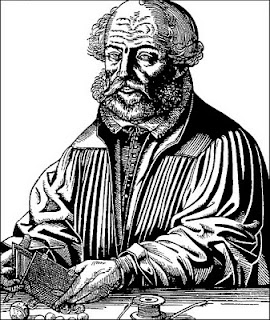 After Martin Luther's death, political changes altered the face of the Evangelical (Lutheran) Church. Emperor Charles V exercised control over all of southern Germany and most of the north. The Augsburg Interim, a capitulation disguised as a compromise, denied justification by grace through faith alone. It also officially recognized seven sacraments, confessed transubstantiation, and re-instituted the Mass as a sacrificial thank offering. Most of the defeated Lutheran princes went along with the Interim.
After Martin Luther's death, political changes altered the face of the Evangelical (Lutheran) Church. Emperor Charles V exercised control over all of southern Germany and most of the north. The Augsburg Interim, a capitulation disguised as a compromise, denied justification by grace through faith alone. It also officially recognized seven sacraments, confessed transubstantiation, and re-instituted the Mass as a sacrificial thank offering. Most of the defeated Lutheran princes went along with the Interim.Although Philipp Melanchthon initially opposed the Augsburg Interim, some combination of fear and his conciliatory nature led him to accept its demands. The damage continued with the Leipzig Interim, which continued to compromise justification by faith while also restoring Catholic rites to Baptism, reintroducing Corpus Christi processions, and otherwise granting favor to Roman practice.
During the same period, a number of doctrinal controversies intruded among the Lutherans. Some grew out of Melanchthon's ongoing compromises with either Rome or the Reformed. Others sprang from the reactionary excesses of his opponents, including Matthias Flacius. Almost two dozen confessions ranging widely across the doctrinal spectrum were composed between 1546 and 1577, variously appealing to the Augsburg Confession for support of often contradictory positions.
 In the early 1570s, Jakob Andreae published Six Christian Sermons against the Philippist party and other Crypto-Calvinists. Meanwhile, Elector Augustus of Saxony, a staunch Lutheran who had been deceived by the Crypto-Calvinists and had actively opposed Lutheran theologians, came to his senses when confronted with Joachim Cureus's refutation of the Evangelical understanding of the Lord's Supper. He imprisoned many of those who'd misled him and began active support and encouragement of a uniting Lutheran confession.
In the early 1570s, Jakob Andreae published Six Christian Sermons against the Philippist party and other Crypto-Calvinists. Meanwhile, Elector Augustus of Saxony, a staunch Lutheran who had been deceived by the Crypto-Calvinists and had actively opposed Lutheran theologians, came to his senses when confronted with Joachim Cureus's refutation of the Evangelical understanding of the Lord's Supper. He imprisoned many of those who'd misled him and began active support and encouragement of a uniting Lutheran confession.Martin Chemnitz urged Andreae to revise and edit his Six Sermons into a formal statement of harmony. Andreae responded with the eleven articles of the Swabian Concord. Chemnitz and David Chytraeus added further revisions, producing the Swabian-Saxon Concord. Meanwhile Balthasar Bidembach and Lukas Osiander the elder had also composed a proposed uniting document, the Maulbronn Formula. Andreae, Chemnitz, David Chytraeus, Nikolaus Selnecker, and others met in Torgau from 28 May-7 June 1576 and drew the Swabian-Saxon Concord and the Maulbronn Formula together into the Torgau Book.
Elector Augustus received and passed along suggestions and criticisms of the Torgau Book to its authors, hoping that one more round of work would complete the task. Chemnitz, Andreae, Selnecker, Chytraeus, Andreas Musculus, and Christophorus Cornerus joined to complete the Bergen Book, which became known as the Solid Declaration or the Thorough Declaration. As this was being done, Andreae also worked on an Epitome or summation of the same doctrinal articles. The six men's work was completed by 28 May 1577.
These two works were included together as the Formula of Concord in the Book of Concord of 1580, along with the three Creeds and the Unaltered Augsburg Confession, the Apology to the Augsburg Confession, the Small and Large Catechisms, the Smalcald Articles, and the Treatise on the Power and Primacy of the Pope. The Epitome briefly summarizes each controversy, confesses true doctrine, and rejects and condemns false teaching. The Solid Declaration is less rigid in structure, instead delving into each topic in great length.
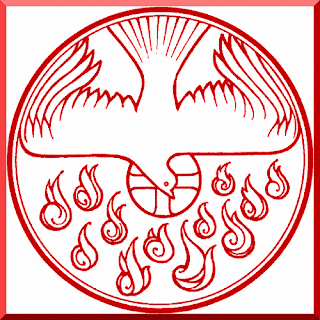 Pentecost, an Israelite festival connected to the spring harvest, was the time chosen by the Lord for the special outpouring of the Holy Spirit upon the disciples as they waited in Jerusalem.
Pentecost, an Israelite festival connected to the spring harvest, was the time chosen by the Lord for the special outpouring of the Holy Spirit upon the disciples as they waited in Jerusalem.With wind and fire, the Holy Spirit manifested Himself upon the apostles. Immediately, they rushed out to begin proclaiming the Gospel of Jesus Christ crucified for our sins and raised for our justification. The account is in Acts 2:1-41. Such was the power of the Holy Spirit working through Law and Gospel preaching that He converted over 3000 people faith in Christ at one time.
In Christianity, Pentecost is a "movable feast." Under the Old Covenant, including among modern Jews, Pentecost was (and is) the fiftieth day of Passover. The Christian Church, as more Gentiles swelled its ranks, kept the idea of the fiftieth day but based the celebration on the date for Easter rather than for Passover. See the second question under Notes on the Christian Calendar for a bit more on how we arrive at a date each year.
Lection: Three Year Cycle, Series B
Psalm 139:1-16
Ezekiel 37:1-14
Acts 2:1-21
John 15:26-27, 16:4b-15
Lection: One Year Cycle
Psalm 143
Genesis 11:1-9
Acts 2:1-21
John 14:23-31
Collect
O God, on this day You once taught the hearts of Your faithful people by sending them the light of Your Holy Spirit. Grant us in our day by the same Spirit to have a right understanding in all things and evermore to rejoice in His holy consolation; through Jesus Christ, Your Son, our Lord, who lives and reigns with You and the Holy Spirit, one God, now and forever.
Technorati Tags: The Feast of Pentecost | The Day of Pentecost | Pentecost | Holy Ghost | Holy Spirit | disciples | apostles | tongues of fire | Church Year | pneumatology | liturgics | liturgical calendar | Christian feasts | lectionary | historical theology | vernacular | translation | Jesus | Christ | Law and Gospel | preaching | conversion | Scripture translation | Church history | Christianity| Christian| Lutheranism | Confessional Lutheran | Aardvark Alley
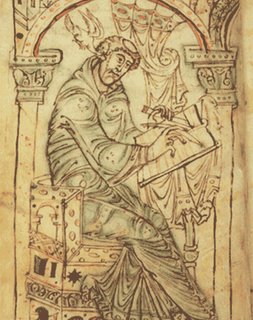 Today marks the heavenly birthday of Bede (pronounced BĒD). Since his commemoration often falls near the end of Eastertide, it's quite likely that many Christians have close familiarity with one of Bede's best known (and one of this Aardvark's favorite) hymns, the Ascension anthem "A Hymn of Glory Let Us Sing."
Today marks the heavenly birthday of Bede (pronounced BĒD). Since his commemoration often falls near the end of Eastertide, it's quite likely that many Christians have close familiarity with one of Bede's best known (and one of this Aardvark's favorite) hymns, the Ascension anthem "A Hymn of Glory Let Us Sing."Bede (673-735) was the last of the early church fathers and the first to compile the history of the English church. Born in Northumbria, Bede was given by his parents to a monastery in Northern England at the age of seven. He was ordained when he was thirty.
Probably the most learned man of his time, he was a prolific writer of history and his careful use of sources provided a model for historians in the Middle Ages. His skill in both history and theology gave him the ability to complete a synthesis between the older Celtic monasticism and the later Rule of Saint Benedict.
Known best for his book Historia ecclesiastica gentis Anglorum (The Ecclesiastical History of the English People), he was also a profound interpreter of Scripture; his edition of the Vulgate was the standard in Catholicism until 1979 and his commentaries still provide fresh insights for today's readers.
Bede also popularized the use of Anno Domini Nostri Iesu Christi ("in the Year of Our Lord Jesus Christ") in speaking of the time since our Savior's birth. This is usually shortened to Anno Domini or AD.
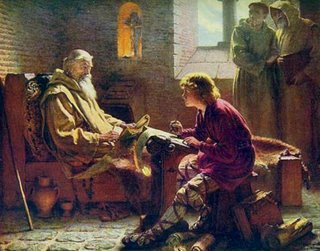 His most famous disciple, Cuthbert, reported that Bede was working on a translation of John's Gospel into English when death came. He also said that Bede died with the words of the Gloria Patri on his lips.
His most famous disciple, Cuthbert, reported that Bede was working on a translation of John's Gospel into English when death came. He also said that Bede died with the words of the Gloria Patri on his lips.Attested hymns include Hymnum canentes martyrum ("The Hymn for Conquering Martyrs Raise"), Hymnum canamus Domino (translated variously as "A Hymn of Glory Let Us Sing," "The Hymn of Glory Sing We," and "Sing We Triumphant Hymns of Praise"), and Praecursor altus luminis ("The Great Forerunner of the Morn"). He also wrote vernacular poetry.
Bede received the title "Venerable" within two generations of his death and is buried in Durham Cathedral as one of England's greatest saints.
Lection — ESV Except as Noted
Psalm 78:1-4 or 19:7-14
Wisdom 7:15-22 (NRSV)
Matthew 13:47-52
Collect
Heavenly Father, who called your servant Bede, while still a child, to devote his life to Your service in the disciplines of religion and scholarship, grant that as he labored in the Spirit to bring the riches of Your truth to his generation, so we, in our various vocations, may strive to make You known in all the world; through Jesus Christ our Lord, who lives and reigns with you and the Holy Spirit, one God, now and forever.
A Hymn of Glory Let Us Sing
A hymn of glory let us sing New songs throughout the world shall ring
Alleluia, Alleluia.
Christ, by a road before untrod Ascendeth to the throne of God.
Alleluia, Alleluia, Alleluia, Alleluia, Alleluia.
The holy apostolic band Upon the Mount of Olives stand
Alleluia, Alleluia.
And with His followers they see Jesus' resplendent majesty
Alleluia, Alleluia, Alleluia, Alleluia, Alleluia.
To Whom the angels drawing nigh, "Why stand and gaze upon the sky?"
Alleluia, Alleluia.
"This is the Savior," thus they say. "This is His noble triumph day."
Alleluia, Alleluia, Alleluia, Alleluia, Alleluia.
"Again ye shall behold Him so, As ye have today seen Him go."
Alleluia, Alleluia.
"In glorious pomp ascending high Up to the portals of the sky."
Alleluia, Alleluia, Alleluia, Alleluia, Alleluia.
O grant us thitherward to tend And with unwearied hearts ascend,
Alleluia, Alleluia.
Unto Thy kingdom's throne, where Thou As is our faith, art seated now,
Alleluia, Alleluia, Alleluia, Alleluia, Alleluia.
Be Thou our Joy and strong Defense, Who art our future Recompense,
Alleluia, Alleluia.
So shall the light that springs from Thee Be ours through all eternity,
Alleluia, Alleluia, Alleluia, Alleluia, Alleluia.
O risen Christ, ascended Lord, All praise to Thee let earth accord,
Alleluia, Alleluia.
Who art, while endless ages run, With Father and with Spirit One,
Alleluia, Alleluia, Alleluia, Alleluia, Alleluia.
More on Bede's hymns and related information from NetHymnal.
Technorati Tags: The Venerable Bede | Bede | Saint Bede | St. Bede | The Ecclesiastical History of the English People | Historia ecclesiastica gentis Anglorum | Northumbria | Anno Domini Nostri Iesu Christi | Anno Domini | A.D. | hymnody | historiography | history | Church Year | liturgical calendar | Christianity | Christian feasts | biography | hagiography | commemorations | lectionary | historical theology | practical theology | exegetical theology | exegetics | vernacular | translation | Bible translation | Scripture translation | liturgics | Church history | European history | English history | British history | Middle Ages | monasticism | Aardvark Alley
 Esther is the heroine of the biblical book that bears her name. Her Jewish name was Hadassah, which means "myrtle." Her beauty, charm, and courage served her well as queen to King Ahasuerus. In that role she was able to save her people from the mass extermination that Haman, the king's chief adviser, had planned (2:19-4:17).
Esther is the heroine of the biblical book that bears her name. Her Jewish name was Hadassah, which means "myrtle." Her beauty, charm, and courage served her well as queen to King Ahasuerus. In that role she was able to save her people from the mass extermination that Haman, the king's chief adviser, had planned (2:19-4:17).Esther's efforts to uncover the plot resulted in the hanging of Haman on the very same gallows that he had built for Mordecai, her uncle and guardian. Then the king named Mordecai minister of state in Haman's place. This story is an example of how God intervenes on behalf of his people to deliver them from evil, as here through Esther he preserved the Old Testament people through whom the Messiah would come.
Even though the book nowhere bears the name of the Lord (Yahweh), it is included in the canon of Scripture because it shows His providential protection of His people as He preserved the line of the Messiah.
Technorati Tags: Esther | Hadassah | Ahasuerus | King Ahasuerus | Lord | Yahweh | God | Haman | Mordecai | providence | Bible | Old Testament | Bible history | Church Year | liturgical calendar | Christianity | Christian | Lutheran | Lutheranism | Christian feasts | biography | hagiography | commemorations | lectionary | exegetical theology | Aardvark Alley
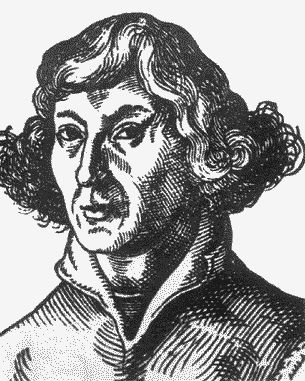 Mikołaj Kopernik was born in Poland in 1473. His parents died when he was twelve and his uncle Lucas Watzenrode assumed responsibility for him and his three siblings. The uncle, soon to be Bishop of Ermland, sent him to the University of Cracow, where Mikołaj studied astronomy. He then matriculated at Bologna (Greek, mathematics, Plato), Padua (law and medicine), and Ferrara (Doctor of Canon Law). At some point during his studies he Latinized his name to the now familiar Nicolaus Copernicus.
Mikołaj Kopernik was born in Poland in 1473. His parents died when he was twelve and his uncle Lucas Watzenrode assumed responsibility for him and his three siblings. The uncle, soon to be Bishop of Ermland, sent him to the University of Cracow, where Mikołaj studied astronomy. He then matriculated at Bologna (Greek, mathematics, Plato), Padua (law and medicine), and Ferrara (Doctor of Canon Law). At some point during his studies he Latinized his name to the now familiar Nicolaus Copernicus.He returned home after being elected a canon of Frauenberg Cathedral. There he assisted his uncle until Watzenrode's death. After this, he then opened a free medical clinic for the poor.
Nicolaus's varied interests included theology, poetry, and the natural and social sciences. He seems to have been the first person to formulate what is now known as Gresham's Law, "Bad money drives out good." This means that if there are two kinds of coins in circulation having the same legal or face value, but one is more valuable in terms of its content, consumers will tend to hoard the more valuable coins and spend the less valuable. Soon only the cheaper coins will be in circulation. This idea has been proven out many times, including in the United States, as base metal coins chased their silver equivalents from circulation during the 1960s and beyond.
Above all else, we remember Nicolaus Copernicus as an astronomer. In his day, the common view of the world was the geocentric model — the earth was motionless and all the heavenly bodies revolved around it. However, others held a heliocentric view, believing that the earth moved about the sun. Already a century before Galileo's birth, Cardinal Nicholas of Cusa wrote, "When we say that the earth does not move, we mean simply that the earth is the point with reference to which man makes his observations of celestial phenomena."
However, this view was much in the minority and most though that the science proved that the earth sat still amidst all Creation. At the same time, the notion that medieval medieval Christians thought the earth flat has been largely disproved. Among those who never held this view were Dante, who referred to the earth as a sphere in the early 1300's and Thomas Aquinas in the opening portion of his Summa Theologica. Other early "round earth" Christians included the Venerable Bede and Irenaeus, already in the late 100s AD. At issue was the motion, not the shape, of the earth.
A unified theory of the cosmos remained a major stumbling block. Because he geocentric model was interwoven with related theories in philosophy, chemistry, physics, music, natural theology, and the like, it seemed that rejecting any single part endangered the whole theory. Ever more accurate measurements ot the celestial bodies, however, imposed ever more increasing burdens upon the defenders of geocentrism. The patches applied by astronomers and mathematicians couldn't cover all the old theory's holes
 Copernicus proposed an elegantly simple solution — suppose that the sun, not the earth, was at the center. His first summary of this theory came in 1530 in a paper called the Commentariolus ("little commentary") and received papal approval. He spent the next thirteen years revising it and expanding his heliocentric theory to book length, all the while rechecking his calculations. As he continued, he constantly rewrote his arguments and delayed publication until absolutely certain that he'd not overlooked a thing.
Copernicus proposed an elegantly simple solution — suppose that the sun, not the earth, was at the center. His first summary of this theory came in 1530 in a paper called the Commentariolus ("little commentary") and received papal approval. He spent the next thirteen years revising it and expanding his heliocentric theory to book length, all the while rechecking his calculations. As he continued, he constantly rewrote his arguments and delayed publication until absolutely certain that he'd not overlooked a thing.When satisfied that he need add or change nothing, Copernicus entrusted the final draft to Georg Rheticus, a former student who became a professor at Leipzig. Rhaeticus published it there. Lutheran pastor Andreas Osiander added an unauthorized preface stating that the heliocentric model was only a device to simplify computations. He said that Copernicus wrote his heliocentric account as a mere mathematical hypothesis, not as anything containing truth or even great probability. Copernicus received delivery of the printed book, De Revolutionibus Orbium Coelestium ("On the Revolutions of the Heavenly Spheres"), only a few hours before his death in 1543.
His work originally found little opposition. Perhaps it would have slowly entrenched itself throughout Western thought, but De Revolutionibus ran into trouble because of Galileo Galilei. When Galileo quarreled with the Italian University establishment and then with the Pope, the whole geocentric model came into question. Because of this, Copernicus's book was placed on the Index donec corrigetur ("until it be corrected") from 1616 to 1758.
Some of Copernicus's ideas didn't stand the test of time. Because the circle was considered a much more elegant — even perfect — form, he resisted the notion of eliptical orbits (as did Galileo), settling instead for a much more cumbersome system of epicycles. Even after Johannes Kepler insisted that the ellipse was the only orbit that made sense of the data, acceptance of his thought took a number of years.
Collect
Almighty God, who made the heavens to tell Your glory and the firmament to proclaim Your handiwork, we thank You for placing us in a universe governed by Your will according the to laws of Your creation and we bless You for giving us mind capable of studying Your creation and spirits capable of wonder at its majesty; today we praise you especially for the gifts of intellect that You pour out upon your servants Nicolas Copernicus and others, by whom our understanding of the nature of Your creation has been advanced, for our good and Your glory, who live and reign, Father, Son, and Holy Spirit, one God, now and forever.
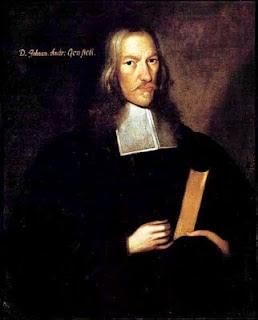 After Martin Chemnitz and Johann Gerhard, Johannes Andreas Quenstedt may have been the ablest theologian of the Lutheran church in the period following the death of Martin Luther. A shining light during the period of Lutheran orthodoxy, Quenstedt still offers much to the Church of our day.
After Martin Chemnitz and Johann Gerhard, Johannes Andreas Quenstedt may have been the ablest theologian of the Lutheran church in the period following the death of Martin Luther. A shining light during the period of Lutheran orthodoxy, Quenstedt still offers much to the Church of our day.Born on 13 August 1617 in Quedlinburg, Germany (modern Bundesland Saxony-Anhalt), Quenstedt was nephew to Johann Gerhard. His mother was the noted theologian's sister.
During his early school days, Quenstedt hoped to study under his uncle at the university at Jena. Unfortunately for young Johannes, Gerhard died before he could enroll at the university. Because of this, Quenstedt's mother changed plans and sent her son to Helmstedt. Many Lutherans had doubts about the overall orthodoxy of Helmstedt. However, its fifty mile distance from Quedlinburg allowed his mother to keep him closer to home.
Quenstedt spent six years in his university studies before moving on to Wittenberg in 1644 to continue his education. In spite of his new school's misgivings over his time at Helmstedt, Quenstedt excelled in Wittenberg. As various faculty members began to support and encourage him, he became ever more convinced of the correctness of Lutheran doctrine and gradually developed his own personal style of theological teaching.
As he delved into the Scriptures, the Confessions, and other Lutheran writings, Quenstedt publicly asserted the claims of Lutheran orthodoxy. Therefore, as he bagan his own career as author and lecturer, he was no mere parrot of his famous uncle. He set forth and defended his own convictions, firmly convinced that they rested on Biblical truth.
Quenstedt received an appointment from Wittenberg University as a lecturer in October 1644. At various times during his career he served as professor of theology, logic, and metaphysics. During his early years as lecturer, he continued his studies and received his Doctorate in Theology in 1650.
Despite the seeming ease with which Quenstedt's career progressed, much of his life was difficult. From childhood, he suffered ongoing illnesses and various physical ailments. Joined in marriage in 1651, he saw his wife die before their first wedding anniversary. He remarried in 1653 but his second wife died after only three years. Soon thereafter, Quenstedt married Anna Sabina Scharf. This 1556 union was long and successful, blessed by God with 12 children.
Friedrich August Tholuck referred to Quenstedt as the "bookkeeper and secretary" (Buchhalter und Schriftführer) of Lutheran orthodoxy. This verdict, however, disagrees with the facts and sells a great man short. Although he did much to catalog, organize, and disseminate that which came before him, he also expanded the scope of Lutheran teaching. Well-read and devout, he lived the life that his works espoused, ever displaying a keen intellect and deep understanding of Holy Scripture and Lutheran theology. For all his bold confession, Quenstedt was a quiet, pious, and somewhat private man.
Without question, Quenstedt's Theologia Didactico-Polemica Sive Systema Theologicum (Didactic-Polemic Theology or Systematic Theology) remains his great contribution to the Church. The Systema is no tidy compendium but a massive volume. When published, it would have cost most pastors several weeks' salary — if not more.
Despite the cost, the Systema underwent several printings, testifying to the book's value and the strong demand from clergy and university instructors. Unfortunately, most of the volume remains unavailable in English translation.
The Systema carefully outlines and expounds upon almost all debated and controverted doctrines from the period. Each section is divided into two portions, one didactic, the other polemic. Quenstedt's "polemic," however, differs from many others stemming from the period of Orthodoxy or elsewhere during Church history. Neither harsh or bombastic, his polemics thoughtfully and gently respond to contemporary critics of Lutheranism.
Since the attacks of earlier ages vary little from those of subsequent times, the Systema remains a valuable resource for present-day Lutherans beset by misguided assaults on our teachings and practices.
Suggested Lection
Psalm 46
Isaiah 55:6-11
Romans 10:5-17
John 15:1-11
Collect
O Lord God, heavenly Father, pour out Your Holy Spirit upon Your faithful people, keep them steadfast in Your grace and truth, protect and comfort them in all temptation, defend them against all enemies of Your Word, and bestow on Christ's Church Militant Your saving peace; through Jesus Christ, Your Son, our Lord, who lives and reigns with You and the Holy Spirit, one God, now and forever. Amen.
Lord, keep us steadfast in Your Word!
Sources
Studium (written by Caleb Bassett)
Christian Cyclopedia (Lueker, Poellot, Jackson, eds.)
Wikipedia
Technorati Tags: Johannes Andreas Quenstedt | Johann Quenstedt | J. A. Quenstedt | Johann Gerhard | Martin Luther | Martin Chemnitz | Lutheran | orthodoxy | Lutheran orthodoxy | theology | polemical theology | polemics | systematic theology | systematics | dogmatic theology | dogmatics | historic theology | Theologia Didactico-Polemica Sive Systema Theologicum | Systema | history | Church Year | liturgical calendar | Christianity | Christian | Lutheranism | confessional Lutheran | Lutheran Confessions | festivals | biography | hagiography | commemorations | lectionary | Church history | Christian history | German history | European history
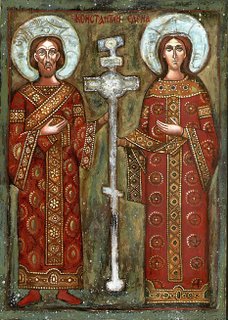 Flavius Valerius Aurelius Constantinus served as Roman Emperor from AD 306 to 337. During his reign the persecution of Christians was forbidden by the Edict of Milan in 313. Ultimately, the faith gained full imperial support.
Flavius Valerius Aurelius Constantinus served as Roman Emperor from AD 306 to 337. During his reign the persecution of Christians was forbidden by the Edict of Milan in 313. Ultimately, the faith gained full imperial support.Constantine took an active interest in the life and teachings of the church and. He called the First Council of Nicaea in 325 at which Saint Athanasius and others defended and defined orthodox Christianity. Among the fruits of this council was one of Christendom's major confessions of faith, the Nicene Creed.
Some argue that Constantine may not have been true believer since he wasn't baptized until his death bed. However, he actively supported Christianity in his later life and even preached upon occasion. Other scholars speculate that he delayed baptism for the same reason as did many others during portions of the Church's history, that of a general misunderstanding of Holy Baptism.
 Many theologians spoke of the need for "satisfaction" — making amends for sins committed during one's life — and warned about time that would be spent in Purgatory by those who didn't make full satisfaction while still living. Indeed, some even taught that unless proper penance was done, one might find himself forever barred from Heaven!
Many theologians spoke of the need for "satisfaction" — making amends for sins committed during one's life — and warned about time that would be spent in Purgatory by those who didn't make full satisfaction while still living. Indeed, some even taught that unless proper penance was done, one might find himself forever barred from Heaven!Since Baptism truly washes away all sin — both that of our birth nature and any transgressions committed later — some thought the best way to avoid Purgatory (or Hell) was to be baptized when one was at death's door. In so doing, people believed that there would be no unrepented, unsatisfied sins remaining that would leave one waiting for eternal bliss or forever denied its blessings.
I'll not argue here the reasons why Lutherans reject the notion of satisfaction or the idea of Purgatory. I'll merely say that if Constantine had such worries, he wasn't alone during his day, and his decision to delay would be understandable in light of such teaching.
Saint Helena, ca. AD 255-329
Constantine's mother Helena strongly influenced her son throughout his life. Her great interest in locating the holy sites of the Christian faith led her to become one of the first Christian pilgrims to the Holy Land. Her research led to the identification of Biblical locations in Jerusalem, Bethlehem, and beyond, which are still maintained as places of worship today. One of Christianity's annual festivals, Holy Cross Day, has its origin in her explorations of Palestine.
Collects
O Lord, our God, King of the universe, who raises up earthly rulers to work Your will in this life, You called Constantine to the imperial throne and ended wide-spread persecution of Your Son's Church; grant that as he served You by fulfilling his vocation, so we would continue to receive from You rulers who allow the Church to proclaim the saving Gospel of Your Son, Jesus Christ, our Lord, who lives and reigns with You and the Holy Spirit, one God, now and forever.
Almighty God, who called your servant Helena to an earthly position of authority so that she might advance your heavenly kingdom, filling her with zeal for your Church and love for Your people, grant that we may be fruitful in good works and steadfast in our faith in Your Son, and finally by your mercy attain everlasting life; through Jesus Christ our Lord, who lives and reigns with you and the Holy Spirit, one God, now and forever.
Technorati Tags: Constantine the Great | Flavius Valerius Aurelius Constantinus | Constantine | Saint Constantine | Constantine I | Helena | Saint Helena | Holy Cross Day | Council of Nicaea | First Ecumenical Council | Nicene Creed | Niceno-Constantinopolitan Creed | Athanasius | Nicaea | Church Year | liturgical calendar | Christianity | Christian | Lutheran | Lutheranism | Christian feasts | biography | hagiography | commemorations | lectionary | historical theology | Church history | European history | Aardvark Alley
 Erik Jedvardsson (Edward's Son) ruled much of Sweden from 1150 to 1160. He headed a Christian kingdom bordered by various pagan realms, all of which shared an ancient tradition of fighting with each other. During the middle of his reign, about 1155, he led a Swedish expedition into Finland, which was then loosely under Swedish rule. The objects were the consolidation of Swedish authority and the establishment of a protected Christian mission. This latter was headed by the English-born Henry of Uppsala, considered by many the founder of the Church in Finland.
Erik Jedvardsson (Edward's Son) ruled much of Sweden from 1150 to 1160. He headed a Christian kingdom bordered by various pagan realms, all of which shared an ancient tradition of fighting with each other. During the middle of his reign, about 1155, he led a Swedish expedition into Finland, which was then loosely under Swedish rule. The objects were the consolidation of Swedish authority and the establishment of a protected Christian mission. This latter was headed by the English-born Henry of Uppsala, considered by many the founder of the Church in Finland.Erik also gained renown for measures designed to to provide Sweden with fair laws and just courts, including steps designed to assist the poor and the infirm. One story of his death goes as follows: On 18 May 1160, the day after Ascension Day, while worshiping in an Uppsala church, word came that a pagan Danish army was approaching to kill him. He replied, "Let us at least finish the sacrifice. The rest of the feast I shall keep elsewhere." As he left the church, the pagans rushed upon him and killed him.
Other accounts claim that he was assassinated by Emund Ulvbane, who worked for the rival house of Sverker. Still another story says that the rival claimant Magnus Henriksson either caused or arranged Erik's death. The history of his recognition and official canonization is somewhat blurred. Regional fervor favored him but church politics seemingly denied him papal recognition. Indeed, Pope Alexander III, using the pretext that Erik was a boozer who died in a drunken brawl, censured his cult in 1172. Although no sources say anything officially, one must wonder if Swedish nationalism following this slight might have helped the Reformation later gain rapid inroads in Sweden.
Erik was honored both as an upholder of the Christian faith and as a national hero, the ancestor of a long line of Swedish kings. His bloodline also spread by marriage into the courts of Norway and Denmark. Within thirty years of his death, he was listed on the Swedish sanctorial calendar. He remains honored as the patron of the city of Stockholm and his likeness is on the city's coat of arms (above). He is also held as the principal patron of Sweden. His silver casket still sits in Uppsala's cathedral.
Collect
O God, who called Your servant Erik of Sweden to an earthly throne and allowed him to advance Your heavenly kingdom, giving him zeal for Your Church and love for Your people, mercifully grant that we who commemorate him this day may be fruitful in good works, and attain to the glorious crown of Your saints; through Jesus Christ our Lord, who lives and reigns with you and the Holy Spirit, one God, now and forever.
Technorati Tags: Saint Erik | Saint Eric | King Erik IX of Sweden | Erik Jedvardsson | Sweden | Church Year | liturgical calendar | sanctorial calendar | Christianity | orthodox Christianity | Christian | Lutheranism | Lutheran | festivals | saints' days | Scripture | Bible | biography | hagiography | commemorations | lectionary | history | historical theology | Church history | Christian history | European history | Swedish history | Scandanavian history
Lection
† Psalm 110 (1-year Lectionary) or Psalm 47 (3-year)
† 2 Kings 2:5-15 (1-year) or Acts 1:1-11 (3-year)
† Acts 1:1-11 (1-year) or Ephesians 1:15-23 (3-year)
† Mark 16:14-20 or Luke 24:44-53 (1-year) or Luke 24:44-53 (3-year)
Collect
Almighty God, as Your only-begotten Son, our Lord Jesus Christ, ascended into the heavens, so may we also ascend in heart and mind and continually dwell there with Him, who lives and reigns with You and the Holy Spirit, one God, now and forever.
An Ascension Hymn
Alleluia! Sing to Jesus
Alleluia! Sing to Jesus; His the scepter, His the throne;
Alleluia! His the triumph, His the victory alone.
Hark! The songs of peaceful Zion Thunder like a mighty flood:
" Jesus out of every nation Has redeemed us by His blood."
Alleluia! Not as orphans Are we left in sorrow now;
Alleluia! He is near us: Faith believes, nor questions how.
Though the cloud from sight received Him When the forty days were over,
Shall our hearts forget His promise: "I am with you ever-more"?
Alleluia! Bread of heaven, Here on earth our food, our stay;
Alleluia! Here the sinful Flee to You from day to day.
Intercessor, Friend of sinners, Earth’s Redeemer, hear our plea
Where the songs of all the sinless Sweep across the crystal sea.
Alleluia! King eternal, Lord omnipotent we own;
Alleluia! Born of Mary, Earth Your foot-stool, heaven Your throne.
As within the veil You entered, Robed in flesh, our great high priest,
Here on earth both priest and victim In the eucharistic feast.
Alleluia! Sing to Jesus; His the scepter, His the throne;
Alleluia! His the triumph, His the victory alone.
Hark! The songs of peaceful Zion Thunder like a mighty flood:
"Jesus out of every nation Has redeemed us by His blood."
Nikolaus von Amsdorf was one of the members of the German nobility who came to follow Martin Luther and to support his reforms. While some questions remain, it's likely that he was born in Torgau on the Elbe River. As he left childhood, he came first to study in Leipzig in 1500. However, he left there two years later and went to the newly established University of Wittenberg. As one of the school's first students, he fell under Luther's influence and quickly abandoned the medieval scholasticism into which he'd been previously educated.
He soon became an intimate friend of Luther and held tightly to the Reformer's teachings. When Luther attended the Leipzig Disputation (1519), Amsdorf accompanied him. He also followed with him to the Diet of Worms in 1521, and was one of the few who knew of Luther's whereabouts during his time at the Wartburg.
He became pastor and superintendent of the church Magdeburg in 1524 and actively introduced and championed the Reformation in that city. His church order closely paralled that of Wittenberg. He went on to similar positions in Goslar and Einbeck, where he continued to support reform. He participated in the Schmalkald discussions in 1537 and, in 1539, strongly opposed Philip of Hesse's bigamy.
His theological position, once firmly established, stayed in strict adherence with that of Luther. This led to dogmatic and ferocious opposition to Philipp Melanchthon, Martin Bucer, and others who represented a policy of conciliation and compromise both among other reformers and toward Roman Catholicism. Amsdorf's opposition was largely credited for the conciliatory Regensburg Conference of 1541. In that same year, and against strong opposition, Elector John Frederick appointed him Bishop of Naumburg-Zeitz.
The Battle of Mühlberg (1547) led him to seek refuge in from the Duke of Weimar. Seeing Wittenberg turn in a Melanchthonian direction, he worked under the Duke of Weimar to establish a new university at Jena in 1548. Theological differences likewise led him to take charge of compiling and editing the Jena Edition of Luther's works, as he sought to correct errors and omissions which Luther's staunchest followers claimed had crept into the Wittenberg edition.
In 1552, he was made superintendent at Eisenach. There he joined with Matthias Flacius against the Philippists and Adiaphorists. Amsdorf's support led Jena to call Flacius to head its theological department.
Amsdorf deserves much of the credit — or blame, in the minds of some — for precipitating a formal and complete break between the Gnesio-Lutheran (orthodox) party and followers of Melanchthon at the colloquy of Worms (1557). Throughout much of his later career, he argued against those who claimed that good works were in any way responsible for salvation. Among the conflicts of this ongoing war were the Majoristic Controversy, the Osiandrian Controversy, and the Synergistic Controversy.
During these struggles, his theology and his personality led Amsdorf espouse the extreme position that good works are actually detrimental to the welfare of the soul. He seems to have meant those works that man thinks are good, God-pleasing, and done in order to attain salvation. However, other Lutherans judged that he and others of like mind had gone beyond (and even against) Scripture in this matter.
Flacius allowed his distrust of good works to become an extreme position regarding Original Sin. This led to his expulsion, along with others, from Jena in 1561. However, Amsdorf was spared because of his advanced age, his great service to Lutheranism, and the general opinion that he'd overreacted but likely didn't profess the same understanding of original sin as espoused by the Flacian party.
Nicolaus von Amsdorf died at Eisenach in 1565 and was buried in the Church of Saint George. There his effigy remains, showing a well-knit frame and sharp-cut features.
The second Sunday of May is Mother's Day here in these United States. From its origins in 19th Century feminism and pacifism, the day grew into a general celebration of motherhood — and a bonanza for greeting card companies, florists, and gift sellers looking to make a few bucks on others' holiday zeal (or guilt). I won't belabor any of these points, although if you and your mom are somehow estranged, you have no day like today to start getting in touch with her.
No, the "Mom" in the apologetic title is another mother — the Mother of all Believers. And every Sunday is chock-full of kids who should be sorry about their neglect of her the day, the week, the month, or the year(s) before. Yeah, that Mother ... Holy Mother Church, the Bride of Christ, the woman of Revelation 12 whose offspring are borne in her womb and birthed in her font.
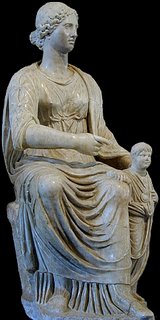 Mom doesn't want the kids just to visit on Christmas, Easter, and maybe Mother's Day. She'd like to have every one of us around all the time. All the good our Father brings home — reconciliation, protection, guidance, and direction — she readily shares with her family. She sets the table with the wonderful meal provided by her Firstborn Son and invites the rest of us to eat and drink. She misses the kids when they're too busy with other stuff to even drop by for a couple hours each week.
Mom doesn't want the kids just to visit on Christmas, Easter, and maybe Mother's Day. She'd like to have every one of us around all the time. All the good our Father brings home — reconciliation, protection, guidance, and direction — she readily shares with her family. She sets the table with the wonderful meal provided by her Firstborn Son and invites the rest of us to eat and drink. She misses the kids when they're too busy with other stuff to even drop by for a couple hours each week.Like any good parent, Mother wants us to grow up. Unlike most parents, she doesn't want us to move out. Instead, she wants us to bring up our own families within the family the she's been raising with our Father. Another mouth to feed? No problem! Huge loads of soiled linens? Bring 'em on! Like Father, like Mother: She insists you behave yourself, yet she's always ready to forgive you when you don't.
So, how are you and Mom getting along? Even if it's been a while, she's always glad to see you. Just don't try to fool yourself into thinking that as long as you and Father are on good terms, you can forget about her. You see, they go together. Disrespect and neglect of Mother is disrespect and neglect of Father.
Our Mother's place is our Father's house, and He warns us not to be "neglecting to meet together, as is the habit of some" but rather to cherish and seek out every opportunity to join the rest of the family in encouraging "one another to love and good works. (Hebrews 10:24-25)" Unlike our American secular holiday, the Lord's Day comes around every week — and each new Lord's Day also brings a fresh Mother's Day. With it comes a fresh opportunity to join with our Mother — and all our brothers and sisters — to celebrate our family, to have our dirty clothes replaced with the clean robes of righteousness, to have our spiritual hunger nourished and our need for communion and community met.
One last thing to consider — I remember asking my dad, "If you get Father's Day and Mom gets Mother's Day, why isn't there a Kids' Day?" Echoing who knows how many parents before him, Dad said, "Every day is Children's Day." For the Christian, this is especially true. Every day we live in our Father's grace is a blessed day for us. All our days are extra special when we spend them with our Heavenly Father, our Holy Mother, and all the rest of the family.
So this Mother's Day — and every Sunday — don't forget Mother. Bring a gift if you want; it's not required and she's happy if you just bring yourself. Come back home and rediscover how much she and Father love you.
Someone who regularly writes love letters to and about our Mother is Emily Carder of Quicunque Vult. She readily teaches and regularly reminds us that all Christians — men and women, boys and girls — are "Momma's Boys." Back in 2007, she posted Celebrating Mothers. Along with it, you might also check out 2005's False Momma's Boys.
Technorati Tags: Mother's Day | Holy Mother Church | Holy Christian Church | Christian Church | Church | outside the Church there is no salvation | Extra Ecclesiam nulla salus | worship | family | home | God | Father | Mother | Mom | Lord's Day | Sunday | Gottesdienst | Divine Service | Emily Carder | Aardvark Alley
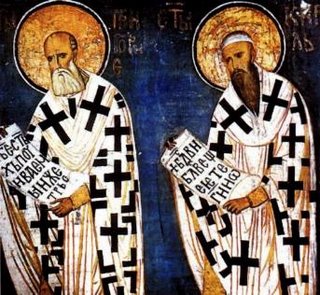 Saint Cyril and Saint Methodius were missionaries to the Slavs. The brothers Constantine and Methodius came from a Greek family in Thessalonica. Younger brother Constantine took the name Cyril when he became a monk in 868. After ordination, Cyril became librarian at the Church of Holy Wisdom (Hagia Sophia) in Constantinople.
Saint Cyril and Saint Methodius were missionaries to the Slavs. The brothers Constantine and Methodius came from a Greek family in Thessalonica. Younger brother Constantine took the name Cyril when he became a monk in 868. After ordination, Cyril became librarian at the Church of Holy Wisdom (Hagia Sophia) in Constantinople.In 862, Emperor Michael III and the Patriarch Photios sent the brothers as to what is now the Czech republic, where they taught in the native Slavic tongue. While the fact of their sending may have included the emperor's political designs, the brothers seem to have focused only upon the spiritual aspect of their task.
Cyril is said to have invented the alphabet known today as Cyrillic, which provided a written language for the liturgy and Scriptures for the Slavic peoples. Slavic alphabets include characters from Greek with extra symbols devised for sounds not expressed in Greek.
Their use of the vernacular established an important principle for evangelical missions. People could be taught directly without needing to first instruct them in the language of the Bible before teaching them what it said about their salvation.
Note: Cyril is traditionally celebrated in many places on 14 February, his date of death, and Methodius is often combined with him. I'm following the lectionary from the new Lutheran Service Book, which moved the brothers' commemoration to 11 May, evidently because so much of the Western Church associates 14 February with Saint Valentine.
Collect
Almighty and everlasting God, who by the power of the Holy Spirit moved your servant Cyril and his brother Methodius to bring the light of the Gospel to a hostile and divided people, overcome all bitterness and strife among us by the love of Christ, and make us one united family under the banner of the Prince of Peace; who lives and reigns with You and the Holy Spirit, one God, now and forever.
Technorati Tags: Saint Cyril | Saints Cyril and Methodius | Saint Methodius | Cyril | Constantine | Methodius | Cyril and Methodius | Cyrillic | Slavic | missionaries | missions | vernacular | translation | Bible translation | Scripture translation | liturgy | Church Year | liturgical calendar | Christianity | Christian | Lutheran | Lutheranism | Christian feasts | biography | hagiography | commemorations | lectionary | historical theology | exegetical theology | Church history | European history | Aardvark Alley
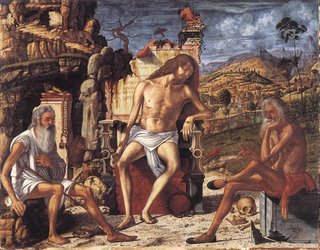 Job was a blameless and upright man who came from Uz (Job 1:1), a land northeast of Canaan. The Book of Job examines the depths of his faith, which was severely tested through the sufferings God permitted.
Job was a blameless and upright man who came from Uz (Job 1:1), a land northeast of Canaan. The Book of Job examines the depths of his faith, which was severely tested through the sufferings God permitted.Despite the sudden death of his ten children and the loss of all his wealth and his health, Job refused to curse God: "Naked I came from my mother's womb, and naked shall I return; the Lord gave, and the Lord has taken away; blessed be the name of the Lord. (1:21)"
In the midst of his tribulations, Job questioned the meaning and purpose of suffering to the point of asserting his own righteousness (34:5-6). Finally, the Lord revealed that a man cannot know the mysteries of God (chapters 38-41). Still, Job's faith in his Redeemer and the resurrection prevailed even in the midst of horrible testing and he made a beautiful confession of faith (19:25-27). In the end, the Lord restored his wealth and blessed him with another seven sons and three daughters.
For a present-day examination of the same issues faced by our brother Job, please see how Ask the Pastor addressed the question Why Suffering and Death? and A Loving God in a Disaster Filled World.
Lection
Psalm 18:1-6
Job 19:23-27
2 Corinthians 11:16-33
Matthew 27:33-50
Collect
O Lord, our Rock and our Salvation, the rejected Stone who became Cornerstone, as the hope of seeing Your Day sustained Job in his trials and gave voice to his confession, we pray that You would engrave Yourself in our hearts and minds and sustain all who trust in You. Let not our troubles in this life cast us down from our secure position in You but keep us steadfast in faith unto life everlasting; for You live and reign with Your Father and the Holy Spirit, one God, now and forever.
Notes on the Art
The Meditation on the Passion, c. 1510, by Vittore Carpaccio, depicts Job (right) and Saint Jerome meditating upon the body of the dead Christ. The marble block upon which Job sits bears the inscription, "I know that my Redeemer lives" and the chair holding the Savior's body includes other Old Testament references to Him. Many details underscore the themes of death and resurrection. Note how the bones next to Job, the crown of thorns propped up against Christ's broken throne, the desolate scenery and wild animals on the left all show death and decay. Meanwhile, the small bird flying upward from Jesus, the engraved words, and the lush landscape to the right give witness to the resurrection and new life in Christ. Painting digtized by the Web Gallery of Art.
Technorati Tags: Job | suffering | affliction | Lord | God | grace | Uz | patriarch | Bible | Old Testament | Bible history | Church Year | liturgical calendar | Christianity | Christian | Lutheran | Lutheranism | Christian feasts | biography | hagiography | historical theology | exegetical theology | Church history | resurrection | I know that my redeemer lives | Gospel | Aardvark Alley
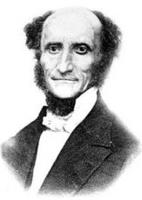 Carl Ferdinand Wilhelm Walther was a founding father of The Lutheran Church — Missouri Synod. He served as its first president from 1847 to 1850 and again from 1864 to 1878. Others who worked with him in the Synod's early days included Friedrich Wyneken and Wilhelm Sihler.
Carl Ferdinand Wilhelm Walther was a founding father of The Lutheran Church — Missouri Synod. He served as its first president from 1847 to 1850 and again from 1864 to 1878. Others who worked with him in the Synod's early days included Friedrich Wyneken and Wilhelm Sihler.The son of a pastor, he was born in Langenchursdorf, Saxony on 25 October 1811. Walther's studies at the University of Leipzig and the influences of older Lutherans helped convince him that Lutheran teachings were correct expositions of Holy Scripture. However, some of his mentors were staunch Pietists, relying heavily on experience and emotion as part of conversion and sanctification. Walther rejected Pietism but seemed to always struggle against its encroachment in his theology.
Fearing a "union church" with the Reformed — as had been happening in Prussia — Walther joined with several other younger pastors under the leadership of Martin Stephan, who encouraged emigration to the United States in order to maintain confessional purity by avoiding imposed unionism. In 1839 he left Germany with other Lutherans. After a series of trials, the party settled along the Mississippi River south of Saint Louis, Missouri. Circumstances still clouded in a certain degree of ambiguity led the Saxons to depose Stephan as their leader and they finally settled upon Walther as his replacement.
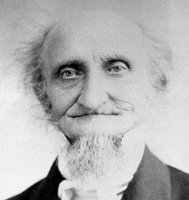 He served as pastor of several congregations in St. Louis, founded Concordia Seminary, and in 1847 was instrumental in the formation of the LCMS (then called the Deutsche Evangelisch-Lutherische Synode von Missouri, Ohio und anderen Staaten — the German Evangelical Lutheran Synod of Missouri, Ohio, and Other States). Walther worked tirelessly to promote confessional Lutheran teaching and doctrinal agreement among all Lutherans in the United States.
He served as pastor of several congregations in St. Louis, founded Concordia Seminary, and in 1847 was instrumental in the formation of the LCMS (then called the Deutsche Evangelisch-Lutherische Synode von Missouri, Ohio und anderen Staaten — the German Evangelical Lutheran Synod of Missouri, Ohio, and Other States). Walther worked tirelessly to promote confessional Lutheran teaching and doctrinal agreement among all Lutherans in the United States.Walther was a prolific writer and speaker. Among his most influential works are Church and Office (aka Church and Ministry) and The Proper Distinction between Law and Gospel. He also published Der Lutheraner, the LCMS's official news magazine for most of the time the Synod spoke and understood German.
Walther was one of many who stood steadfast in confession of the Evangelical, Orthodox, Catholic, and Apostolic Faith. For a sampling of some of the others in Lutheranism, please see The Meanies of Grace.
Lection
Psalm 46
Isaiah 55:6-11
Romans 10:5-17
John 15:1-11
Collect
O Lord God, heavenly Father, we pray that, as You raised up C. F. W. Walther to lead the Lutherans in American into a renewed appreciation of their confessional heritage and trust in the saving Gospel of Jesus Christ, so You would continue to provide them with faithful pastors and leaders, keep them steadfast in Your grace and truth, defend them against all enemies of Your Word, and bestow on Christ's Church Militant Your saving peace; through Jesus Christ, Your Son, our Lord, who lives and reigns with You and the Holy Spirit, one God, now and forever.
Technorati Tags: C.F.W. Walther | Carl Ferdinand Wilhelm Walther | Friedrich Wyneken | Wilhelm Sihler | Church Year | liturgical calendar | Christian | Lutheran | Lutheranism | confessional Lutheran | confessional Lutheranism | orthodox Lutheran | orthodox Lutheranism | commemorations | lectionary | historical theology | church history | Lutheran history | American Lutheran history | American history | biography | The Lutheran Church — Missouri Synod | LCMS | Concordia Seminary | Concordia Seminary, Saint Louis, Missouri | Law and Gospel | The Proper Distinction between Law and Gospel | Church and Office | Church and Ministry | Der Lutheraner | Aardvark Alley



